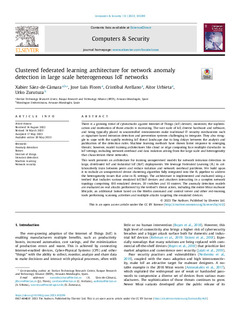| dc.rights.license | Attribution 4.0 International | |
| dc.contributor.author | Zurutuza, Urko | |
| dc.contributor.other | Sáez-de-Cámara, Xabier | |
| dc.contributor.other | Flores, José Luis | |
| dc.contributor.other | Arellano, Cristóbal | |
| dc.contributor.other | Urbieta, Aitor | |
| dc.date.accessioned | 2024-02-02T08:53:12Z | |
| dc.date.available | 2024-02-02T08:53:12Z | |
| dc.date.issued | 2023 | |
| dc.identifier.issn | 0167-4048 (papel) | |
| dc.identifier.issn | 1872-6208 (online) | |
| dc.identifier.other | https://katalogoa.mondragon.edu/janium-bin/janium_login_opac.pl?find&ficha_no=173003 | |
| dc.identifier.uri | https://hdl.handle.net/20.500.11984/6217 | |
| dc.description | APC (formulario). 2790 EUR | |
| dc.description.abstract | There is a growing trend of cyberattacks against Internet of Things (IoT) devices; moreover, the sophistication and motivation of those attacks is increasing. The vast scale of IoT, diverse hardware and software, and being typically placed in uncontrolled environments make traditional IT security mechanisms such as signature-based intrusion detection and prevention systems challenging to integrate. They also struggle to cope with the rapidly evolving IoT threat landscape due to long delays between the analysis and publication of the detection rules. Machine learning methods have shown faster response to emerging threats; however, model training architectures like cloud or edge computing face multiple drawbacks in IoT settings, including network overhead and data isolation arising from the large scale and heterogeneity that characterizes these networks. | |
| dc.language.iso | eng | |
| dc.publisher | Elsevier | |
| dc.rights | © 2023 The Authors | |
| dc.rights.uri | http://creativecommons.org/licenses/by/4.0/ | |
| dc.subject | Anomaly detection | |
| dc.subject | Botnet | |
| dc.subject | Internet of things | |
| dc.subject | Intrusion detection | |
| dc.subject | Machine learning | |
| dc.subject | Network security | |
| dc.title | Clustered federated learning architecture for network anomaly detection in large scale heterogeneous IoT networks | |
| dcterms.accessRights | http://purl.org/coar/access_right/c_abf2 | |
| dcterms.source | Computers and Security | |
| local.contributor.group | Análisis de datos y ciberseguridad | |
| local.description.peerreviewed | true | |
| local.identifier.doi | https://doi.org/10.1016/j.cose.2023.103299 | |
| local.rights.publicationfee | APC | |
| local.rights.publicationfeeamount | 2790 EUR | |
| local.contributor.otherinstitution | https://ror.org/03hp1m080 | |
| local.source.details | Vol. 131. N. art. 103299 | |
| oaire.format.mimetype | application/pdf | |
| oaire.file | $DSPACE\assetstore | |
| oaire.resourceType | http://purl.org/coar/resource_type/c_6501 | |
| oaire.version | http://purl.org/coar/version/c_970fb48d4fbd8a85 | |
| oaire.funderName | European Commission | |
| oaire.funderName | Eusko Jaurlaritza = Gobierno Vasco | |
| oaire.funderIdentifier | https://ror.org/00k4n6c32 http://data.crossref.org/fundingdata/funder/10.13039/501100000780 | |
| oaire.funderIdentifier | https://ror.org/00pz2fp31 http://data.crossref.org/fundingdata/funder/10.13039/501100003086 | |
| oaire.fundingStream | H2020 | |
| oaire.fundingStream | Elkartek 2023 | |
| oaire.awardNumber | 101021911 | |
| oaire.awardNumber | KK-2023-00085 | |
| oaire.awardTitle | A Cognitive Detection System for Cybersecure Operational (IDUNN) | |
| oaire.awardTitle | cyBErsecure industriAl Computing cONtinuum (BEACON) | |
| oaire.awardURI | https://doi.org/10.3030/101021911 | |
| oaire.awardURI | Sin información | |








